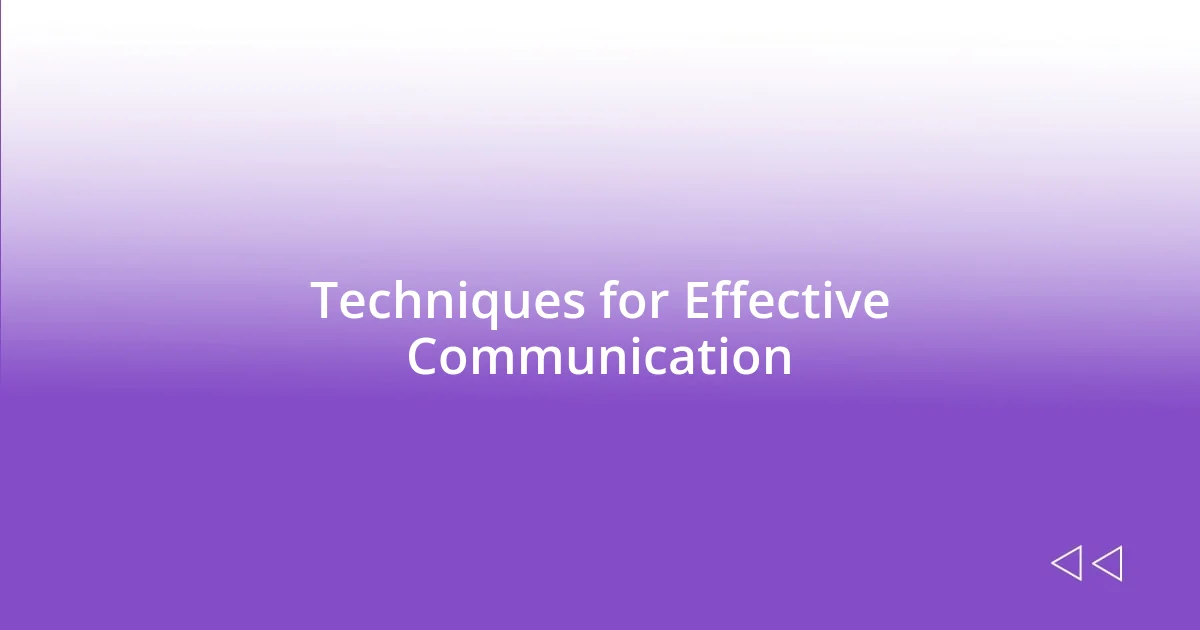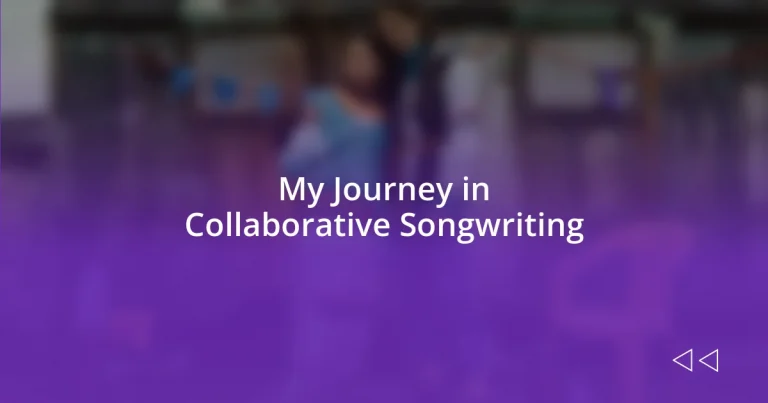Key takeaways:
- Vulnerability in sharing personal stories enhances creativity and fosters deeper connections between collaborators.
- Creating a supportive and open environment, along with active communication, is crucial for effective collaboration and idea sharing.
- Conflicts can lead to growth and innovation when approached with curiosity and a willingness to understand different perspectives.

Understanding Collaborative Songwriting
Collaborative songwriting is an enriching and often exhilarating experience. I remember the first time I co-wrote a song with a friend; we bounced ideas back and forth, feeding off each other’s energy. It felt like a creative dance, where I was able to contribute my unique flair while also embracing her perspectives. Doesn’t that kind of synergy make you curious about how our different backgrounds can shape the music we create together?
In this process, trust becomes essential. I’ve learned that sharing personal stories and emotions can transform lyrics from ordinary to extraordinary. When I’ve opened up about my own struggles or joys, it often struck a chord, not just with my co-writer but also with the listeners. Isn’t it fascinating how vulnerability can lead to powerful art?
Another important aspect is the balance of voices in a song, which can sometimes feel like a juggling act. I recall a session where I had to remind myself that it’s not just about my vision, but about finding a middle ground. Have you ever found a surprising breakthrough during moments of compromise? Those instances remind me that collaborative songwriting isn’t merely about merging ideas; it’s about weaving a tapestry of thoughts and feelings that resonate universally.

Building a Collaborative Environment
Creating a nurturing space for collaboration is key. I’ve found that choosing the right environment can significantly influence our creative output. In one memorable session at a cozy café, the warm ambiance and gentle background music made it easy for us to let down our guards and share our raw ideas. I can’t help but wonder if you’ve ever felt that a change of scenery sparked new inspiration for you.
Active communication is vital in this process. I recall working with a guitarist who encouraged me to vocalize even the slightest ideas. This openness led to moments where we’d bounce back and forth, creating magic from seemingly unformed thoughts. It’s incredible how listening actively not only validates each participant’s input but also builds a stronger connection, don’t you think?
Additionally, setting clear intentions at the beginning of a collaboration can guide the creative journey. I remember when we decided to focus on a theme and a target audience; it became our north star, keeping us aligned even during disagreements. Those conversations about our goals enabled us to refine our ideas, which ultimately enhanced the song’s impact. Have you experienced similar discussions that altered your songwriting trajectory?
| Collaboration Aspects | Insights |
|---|---|
| Environment | Choosing a cozy, inviting space can boost creativity. |
| Communication | Active listening opens up pathways for ideas. |
| Clarity of Intentions | Setting clear goals helps refine the creative journey. |

Techniques for Effective Communication
Effective communication is the backbone of successful collaborative songwriting. I remember a session where we hit a roadblock, and instead of pushing through, I suggested we take a moment to reflect. This pause allowed us to articulate our thoughts and feelings clearly, reigniting our creative spark. Have you watched how a simple break can change the energy in the room? It’s remarkable what a little time and space can do.
Here are some techniques I frequently employ:
- Mirror Each Other’s Ideas: Reflect back what your partner has said to show you’re listening and to clarify understanding.
- Use Non-Verbal Cues: Sometimes a nod or a smile can go a long way in conveying support and enthusiasm.
- Ask Open-Ended Questions: Encourage deeper discussions by asking questions that require more than yes or no responses.
When we create a safe space for dialogue, the magic really happens. I recall sharing an idea that felt too vulnerable to me at first. But when my co-writer responded with genuine excitement, I realized vulnerability could transform doubt into inspiration. It’s these heartfelt exchanges that truly elevate our songwriting.

Sharing Creative Ideas Smoothly
Sharing creative ideas smoothly involves a delicate balance of vulnerability and encouragement. I remember one session where I hesitated to present a lyric I had crafted. It felt risky, but when I finally voiced it, my partner’s enthusiastic response made all the difference. That moment taught me that sharing our ideas, no matter how raw or unpolished, can lead to unexpected breakthroughs. Have you ever felt that surge of relief when someone embraces your creative spark?
To facilitate smooth sharing, I’ve found that using a collaborative document works wonders. By writing our ideas down in real-time, we can easily build upon each other’s thoughts. I can still picture us sitting side by side, typing out concepts, allowing each idea to flow seamlessly into the next. How often do you find that a visual representation of your brainstorming leads to richer discussions?
Cultivating a judgment-free zone is also essential. In a recent collaboration, we agreed that all ideas were valid, setting our egos aside for the greater good of the song. It was liberating to know that each thought was welcomed, no matter how unconventional. This culture of openness didn’t just enhance our creativity; it deepened our connection, making the whole experience more enjoyable. Can you think of a time when a lack of judgment changed the dynamic in your creative processes?

Navigating Conflicts and Differences
Navigating conflicts and differences in collaborative songwriting can feel daunting, but I’ve learned that embracing those moments often leads to the most profound growth. I recall a particularly tense session where my co-writer and I held vastly different views on the song’s climax. Initially, it felt like an impasse, but instead of digging my heels in, I suggested we list our top three emotional impacts we wanted the audience to feel. This exercise opened the door to a compromise that blended both visions beautifully. Have you ever experienced a conflict that turned into something unexpectedly rewarding?
When differences arise, I find it’s crucial to remember that each perspective adds a layer to the song. I once had a strong opinion about a melody that my partner thought was too simplistic. Rather than dismissing their feedback, I decided to explore their vision by improvising a few chords. To my surprise, their approach brought a vibrant energy that transformed the track. It’s fascinating how stepping back and taking the time to genuinely understand someone else’s viewpoint can lead to a richer, more diverse creation. What’s your strategy for bridging the gap when creative ideas clash?
It’s important to approach these conflicts with a spirit of curiosity rather than defensiveness. In one instance, I was caught off guard when a co-writer challenged a key lyric of mine. Instead of reacting emotionally, I took a breath and asked them what they felt was missing. Their insights led to a breakthrough that not only improved the lyric but deepened our trust and collaboration. I often find that when I ask questions with an open heart, it not only diffuses potential tensions but creates a space where innovation flourishes. How do you cultivate that spirit of curiosity within your own collaborations?

Finalizing the Song Together
Finalizing a song together is where all the creative energy comes to fruition, and it’s truly exhilarating. I vividly recall a moment when we were piecing together the final parts of our song. We sat in a cozy café, the aroma of coffee swirling around us, and as we listened to the draft once more, the excitement in the air was palpable. Each adjustment we made felt like unveiling a hidden gem, don’t you agree?
One crucial aspect of finalizing a song is the art of compromise, which I learned firsthand during a recent collaboration. There was a point where I was adamant about keeping a specific chorus, but my partner felt it didn’t resonate with the rest of the song. After some back and forth, I suggested we blend my original idea with theirs, creating something that felt fresh yet true to both visions. I can’t help but think: how often does collaboration push you to discover moments that wouldn’t emerge when working alone?
As we reached the conclusion of our session, we recorded the final version, a rush of emotion washing over us. It felt like we were not just finalizing a song, but also enhancing our bond as co-writers. I remember looking at my partner and sharing a smile, both of us knowing we had created something special together. It’s in these final moments that I realize, there’s a beautiful synergy in collaborative songwriting. What about you? Do you have a ritual for celebrating your completed creations?

Learning from Collaborative Experiences
When I think back on my collaborative experiences, one major lesson stands out: vulnerability fosters creativity. In one collaboration, I hesitated to share a raw, personal verse I had written, fearing it would be too revealing. However, when I finally shared it with my co-writer, their enthusiastic response encouraged me to dig even deeper emotionally. This exchange taught me that showing our authentic selves not only strengthens our connection but enriches the song itself. Have you ever held back out of fear, only to find that sharing your truth was the very thing that brought the project to life?
Another insight I’ve gleaned is the importance of setting a collaborative tone from the get-go. On one occasion, my writing partner and I established a rule: every idea—no matter how wild—would be welcomed without judgment. This mindset transformed our sessions into a safe space for exploration. I remember tossing out an absurd concept for a bridge that we both laughed at, but it sparked an unexpected direction that turned into one of my favorite parts of the song. What ground rules do you think could enhance your collaborative sessions?
Lastly, I’ve learned that reflection is a powerful tool in collaborative songwriting. After finishing a project, I set aside time to evaluate what worked well and what didn’t. In one project, we ran into a snag with transitions, and reflecting on that moment allowed me to recognize that we hadn’t fully communicated our vision. Sharing these reflections with my partner not only led to actionable improvements but deepened our understanding of each other’s creative processes. When was the last time you took a step back to analyze your collaborative journey?














